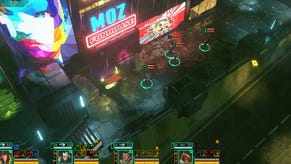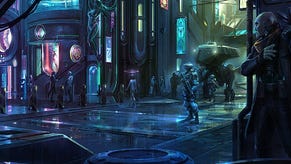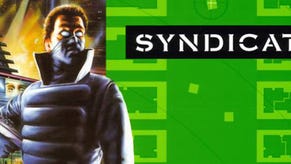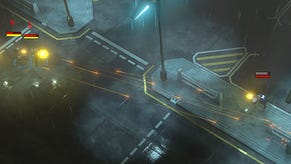How Did They Do... Satellite Reign's Rain?
Wet work
In this irregular column, Marsh Davies stumbles across an impressive effect or neat bit of trickery and asks, “How did they do that?” his eyes brimming with tears of admiration and wonder. Then one of the developers tells him, hopefully using terms that don’t cause the soft mass of his brain to boil out of his ears.
Something about cityscapes at night triggers a very particular kind of excitement in me. I’m not sure exactly what it is - do the streets’ relative desertion imbue a sense of ownership over them which is not possible during the day? Do they feel forbidden or transgressive in some way? Is it about the contrast of light and dark; the possibility of both invisibility and of voyeurism? Whatever it is, some games evoke it with real potency - Deus Ex and Human Revolution, of course; Vampire: The Masquerade - Bloodlines is another; and the Splinter Cell games invariably offer some view of isolation and modernity from the blustery summit of a skyscraper. But perhaps the game which presses that button with the greatest insistence is a new one: Satellite Reign.
It’s an incredible aesthetic consummation: sound and vision conjuring a bustling cityscape of perpetual neon-studded night, simultaneously alive and lonely. And contributing to this in no small part is the rain. No game, I think, has done it this well - from the bleary streaks that flicker down in front of luminescent signs and sodium lights, to the shimmering, slick pavements with their pools and rivulets. I had to know how it was done.
Brent Waller is the environment artist at 5 Lives Studios, and the man responsible for Satellite Reign’s rain-slick streets, along with shader designer Bruno Rime. Over to Waller:
“I remember a few years ago, before we even considered Satellite Reign, I did a portfolio piece of a wet city street at night, although using more crude technology than what we’re using now. It wasn’t a launching point for the game, but when Mike Diskett sent the email round saying, ‘Let’s do a spiritual successor to Syndicate,’ I immediately replied with with that video, saying, ‘I’m in - and I can make it look like this!’
“We didn’t look at too many other games,” says Waller. “In my head, when I think of rain in games, I think of really over-the-top stuff, like water pouring down the side of a building. They often overdo it a little bit, as if to say, ‘Hey look at our cool water effect!’ Whereas we were aiming for something that was more immersive, to suck you into the world rather than draw attention to itself.”
Blade Runner was the obvious touchstone - a place of permanent night and incessant rain - but the films of Christopher Nolan were also an inspiration, with their austere sense of urbanity, cold skyscrapers looming over wet streets. And there’s something a little Batman about the perspective Satellite Reign lends you, peering down through the lashing water onto the street below, just as the Dark Knight might from the cornice of some towering neo-gothic structure.
That bluster of gusting raindrops that separates you from the ground-level, however, is built up from multiple layers, giving the impression of density and depth through clever trickery.
“The rain is a particle effect,” explains Waller. “Each drop is a different particle, but we’re not actually drawing them too far into the world. It would be far too expensive to draw all those particles. Instead, there are lots of different layers to the effect. There’s a screen of particles that sit in front of the camera - that’s what you have for those individual droplets that you see streaking past. And then behind that there are a few occasional very large particles, which we call ‘rain sheets’. If you look at footage of a rainstorm you’ll see individual droplets and, often in addition, big sprays where a gust of wind has caught a heap of rain and blown it across, so you get these thicker masses of rain within the downpour.”
“Those are the two elements we have working there. Then we take a snapshot of what the player sees on screen, and create a blurred and heightened version of that. We add more contrast so the darks get darker and the colours and the lights become a bit more vibrant. And then that’s used as a mask for the raindrops.”
You may have stumbled across the idea of masks while using Photoshop. They act as a filter, indicating how much of another image to show. The darkness or lightness of a mask controls how opaque the resulting image is. If a mask is fully black, the image to which it is applied will be shown as totally transparent, and, conversely, if there are white areas on the mask, the image will show up fully in those areas. In the case of Satellite Reign, this blurred, high-contrast screenshot is used to tell the game how opaquely - and with what colour tint - to draw the water particles. As the rain particle passes into an area where the mask is dark, it disappears from view.
“So that way, when you have a really bright light or something and the rain passes in front of it, it looks like the rain droplet is being illuminated by that street light,” says Waller. “It’s not fully volumetric, but it gives you the illusion of illumination and volume. And, because we blur the mask a bit, we get a bit more of a gradual fall off on the lights, so it looks like the light is getting refracted through the raindrops. We also use that on a fog effect, so the fog gets illuminated and tinted as well.”
The rain particles don’t descend all the way from the camera to the ground - the particles “die”, to use the appropriate jargon, and the impression of continuity to distant, ground level rain is created from the multiple layers of moisture effects, and the agitation of surface water.
“That is probably one of the more complex things we’re doing,” says Waller of the rainslick pavements. “We’re using a relatively new shader technology. What I used to do is, if I was going to make a chrome metal surface, or a brick surface, or any different type of surface, I’d have to make these specular textures [which tell the engine how shiny a surface is] to fake the effect of a particular material. In some cases you’d get it looking good under one set of lighting conditions and then you’d take it to a different lighting condition and need to readjust things. But the good thing about PBR - the Physically Based Rendering shader - is that it uses real world measurements for how light is absorbed by different materials. It’s called light conservation; any surface in the world, if you shine a light on it, a certain amount will be absorbed and a certain amount bounced back. PBR gives you a more natural and predictable result.”
“Then we have a procedural texture that’s layered across that forms all the puddles and the different variances of wetness on the ground,” says Waller. “Because I’m the only environment artist we needed a way of laying out a massive city and making it look wet without me hand-placing puddles.”
This procedural puddle effect is then subject to distortion, simulating the water droplets hitting the ground, and then fed back through the PBR system to get a real world measurement for the light-absorbency of water.
“And then we put that through Candela [a plug-in for Unity that creates Screen Space Reflections]. It offers a cheap way of doing real-time reflections: it only reflects information that the camera can see - so, from our point of view, it’ll reflect the side of the buildings, but if there’s an awning, and the camera can’t see the underside of that awning, it won’t reflect it. That’s the main limitation of Screen Space Reflections, but it’s a lot cheaper than real-time ray-traced reflections.”
All this creates a powerful atmosphere, without being so distracting that it impairs your view of the world or its people - itself quite a balancing act. But as impressive and gorgeous as the effect is, Waller is not yet wholly satisfied. In particular, an area of improvement is the transition between ground water and wet ground.
“When you look at a wet street you’ll see the formation of puddles: the surface of the puddle is perfectly flat, and then outside the puddle you can still see the bumpiness of the ground, but it’s more glossy and shiny. At the moment we’re blending between the two: ideally you’d want to go abruptly between the mirrored puddle look and the glossy ground value. There should be more of a sharp definition between where a puddle starts and where it ends and the surface of the road takes over. If we have the time, we’d like to fix that and make it blend properly between the two.”
He’s a perfectionist, clearly - and that's what it takes to create effects that so move or entrance the viewer. Satellite Reign’s perpetual deluge may be a subtle detail in the grand scheme of the game, but its ability to transport the player to that night-time world of moody streetlights and flickering neon is unparalleled. The game without the downpour would be a poorer game indeed.























